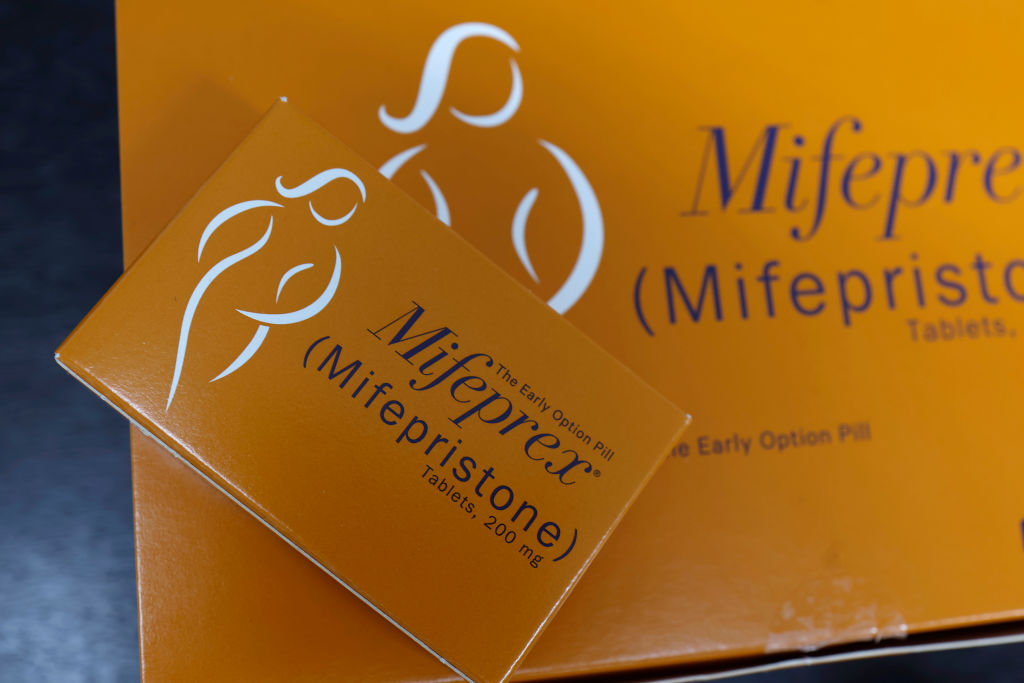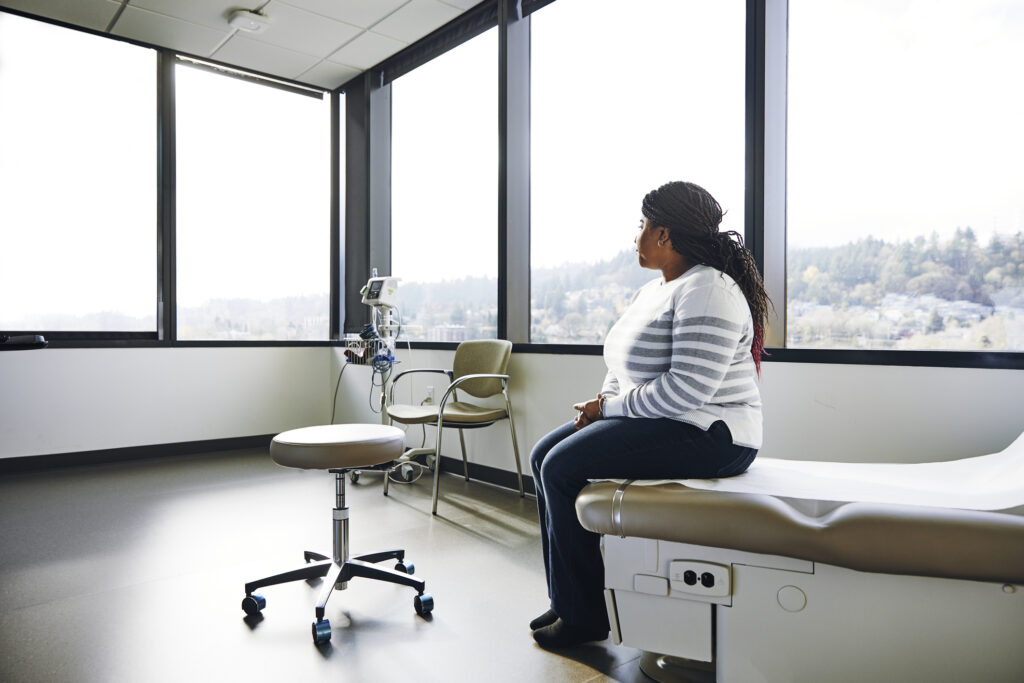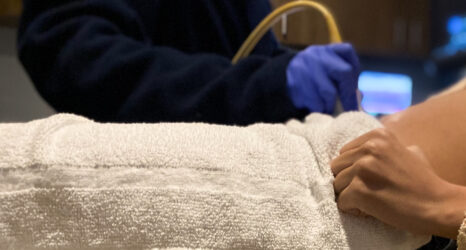Millions of U.S. women are debilitated each year by fibroids. Mifepristone could ease pain and reduce the need for invasive surgery.

Mifepristone has long been politicized by abortion opponents—who have tried to block FDA approval of the medication in the 1990s and are still suing to remove it from the market, despite extensive evidence showing that medication abortion is very safe. But beyond the drug’s uses as an abortion pill, its effectiveness as a treatment for fibroids is going largely unknown and undiscussed. For patients with fibroids, mifepristone could ease pain and reduce the need for invasive surgery. But restrictions placed on mifepristone in response to anti-abortion threats have made mifepristone unavailable for treating fibroids.
Millions of U.S. women are debilitated each year by fibroids, which are noncancerous growths of the uterus that can cause heavy periods, severe pain and difficulty conceiving. Over 26 million women in the U.S. have fibroids, according to the U.S. National Institutes of Health. By the age of 50, up to 70 percent of white women and 80 percent of Black women have fibroids. Fibroids are often treated with invasive surgery to remove the fibroids or with hysterectomies.
Right away, it was obvious: It was a great success. The fibroids shrunk. The bleeding stopped. Patients’ quality of life improved dramatically.
Dr. Steven Eisinger
Extensive research has shown that mifepristone can significantly reduce fibroids. Yet, it is not available for that use in the United States.
Between 2003 and 2011, Dr. Steven Eisinger, a board-certified ob-gyn and professor at the University of Rochester, along with his colleagues, published six peer-reviewed articles showing mifepristone was effective for treating fibroids.
Eisinger described what he observed when giving mifepristone to women with fibroids.
“Right away, it was obvious: It was a great success. The fibroids shrunk. The bleeding stopped. Patients’ quality of life improved dramatically. They felt better, had more energy, more color in their cheeks. They would go about life with a lot more enthusiasm. The scores on quality of life were so dramatically different that we actually considered the possibility that mifepristone was a mood enhancer.”
Before treatment, many of the patients were anemic due to heavy bleeding from fibroids. “Their blood counts went up dramatically,” said Eisinger, who said as little as two micrograms of mifepristone daily effectively reduced fibroids.
Despite these promising results, the National Institutes of Health did not renew the grant supporting the research. Eisinger sought funding to continue the study from Danco Laboratories, the maker of mifepristone. Eisinger said Danco was interested and supportive of the research. Still, the small private company could not fund further research, so he had to drop his plans.
No one else in the U.S. has since pursued research on mifepristone for treating fibroids, but researchers in other countries have.

Research from China, Japan, Italy, India and Nigeria has shown that small doses (5-50 micrograms) of mifepristone are effective for treating fibroids (a 200-microgram dose is used for abortion). Research has shown that the medication reduces menstrual bleeding, relieves pain, improves the quality of life, and can enhance fertility.
In one recent study from India, researchers concluded, “Mifepristone significantly reduced fibroid volume… [it] significantly reduced bleeding and … the side effects were mild and tolerable.”
Other medicines that treat fibroids often have negative side effects, such as reducing bone density. Mifepristone, on the other hand, had no side effects, according to Eisinger.
As a non-surgical alternative for treating fibroids, mifepristone can potentially reduce the need for hysterectomies.
- Approximately 600,000 hysterectomies are performed annually in the U.S.
- Approximately 20 million U.S. women have had hysterectomies.
- The CDC reports that about a third of all women will have a hysterectomy by age 60.
- The National Women’s Health Network argues that “unnecessary hysterectomies have put women at risk needlessly and that health care providers should recognize the value of a woman’s reproductive organs beyond their reproductive capacity and search for hysterectomy alternatives before resorting to life-changing operations.”
Research suggests that mifepristone may also help treat endometriosis. Endometriosis afflicts an estimated 10 percent of reproductive-age women. Common treatments include laparoscopic surgery—cutting and removing endometrial tissue or destroying it with a laser beam or electric current—and hysterectomies.
Research also shows mifepristone effectively treats adenomyosis, a condition in which endometrial tissue exists within and grows into the uterine wall.
Yet, despite mifepristone’s promise to provide women with health-enhancing treatments, the development of the medication for these uses is stymied.
Research from China, Japan, Italy, India and Nigeria has shown that small doses (5-50 micrograms) of mifepristone are effective for treating fibroids (a 200-microgram dose is used for abortion).
How Anti-Abortion Politics Blocked Access to a Vital Medication
The French company Roussel-Uclaf first developed mifepristone, known as RU-486, in 1980. After extensive testing, the company applied for and obtained the French government’s approval in 1988 for the drug to be used for abortion.
The same year, anti-abortion protests in France caused Rousel-Uclaf’s owner Hoechst AG of Germany, to stop distributing mifepristone. The French government responded by ordering Roussel-Uclaf to resume selling the medication in the interest of public health.
French health minister Claude Évin famously explained, “I could not permit the abortion debate to deprive women of a product that represents medical progress. From the moment government approval for the drug was granted, RU-486 became the moral property of women, not just the property of a drug company.”
Great Britain approved mifepristone for abortion in 1991 and Sweden in 1992. But due to pressure from anti-abortion groups, Roussel-Uclaf and Hoechst AG declined to bring the drug to the U.S. market for fear of boycotts and lost profits. Instead, the company donated all rights for medical uses of mifepristone in the U.S. to the Population Council—a nonprofit that conducts reproductive health research.
I could not permit the abortion debate to deprive women of a product that represents medical progress. … RU-486 became the moral property of women.
Claude Évin
The Population Council conducted clinical trials and applied to the FDA for approval. The organization also tried to find a drug company willing to market the drug in the U.S. After threatened boycotts from anti-abortion groups, large drug companies refused, so in 1995, the Population Council gave the rights to distribute mifepristone to a small company named Danco Laboratories, formed specifically for this purpose.
In 2000, the U.S. Federal Drug Administration approved mifepristone for abortion but tightly restricted the medication due to intense anti-abortion pressure. Citing fear of anti-abortion violence, the FDA at the time refused to reveal the manufacturer’s names or the FDA employees involved in approving the drug. The threats were so serious the agency had to increase security at its offices.
Despite strong evidence of mifepristone’s safety, the FDA placed the medication under a REMS—Risk Evaluation and Mitigation Strategy—a drug safety program that allowed only certified doctors to dispense the medication in person. This limited the use or development of mifepristone for the treatment of fibroids.
“Most new applications of existing drugs are discovered and even developed by physicians using drugs off-label, but that path is not easily accessible because of the REMS,” said Francine Coeytaux, co-director and co-founder of Plan C Pills, which educates the public about abortion pills and advocates for greater access.
Meanwhile, drug companies won’t invest in research and development of the medication for fear of long-standing threats of anti-abortion boycotts. As a result, this important medication remains inaccessible to many women who could benefit tremendously from it.
In December 2021, the FDA loosened its restrictions on the medication and, for the first time, allowed pharmacies to distribute mifepristone in January of 2023. But the drug remains under the restrictive and medically unnecessary REMS drug safety program.
Over 40 years after the development of mifepristone and two decades after research was first published showing how effective mifepristone is for treating fibroids, women still do not have access to this medication for this purpose. This critical medicine remains hostage to anti-abortion politics, and women’s health has suffered.
The FDA must remove the REMS, and drug companies must step forward and develop this medication for use in treating fibroids and other related health conditions that afflict millions of women every year—to finally truly make this medication “the moral property of women.”
Up next:
U.S. democracy is at a dangerous inflection point—from the demise of abortion rights, to a lack of pay equity and parental leave, to skyrocketing maternal mortality, and attacks on trans health. Left unchecked, these crises will lead to wider gaps in political participation and representation. For 50 years, Ms. has been forging feminist journalism—reporting, rebelling and truth-telling from the front-lines, championing the Equal Rights Amendment, and centering the stories of those most impacted. With all that’s at stake for equality, we are redoubling our commitment for the next 50 years. In turn, we need your help, Support Ms. today with a donation—any amount that is meaningful to you. For as little as $5 each month, you’ll receive the print magazine along with our e-newsletters, action alerts, and invitations to Ms. Studios events and podcasts. We are grateful for your loyalty and ferocity.





